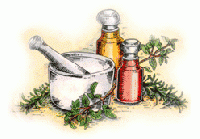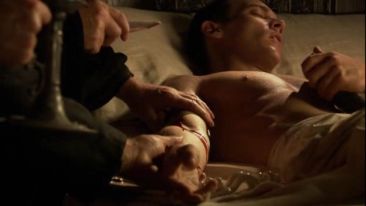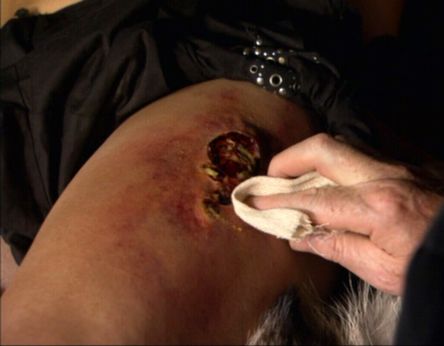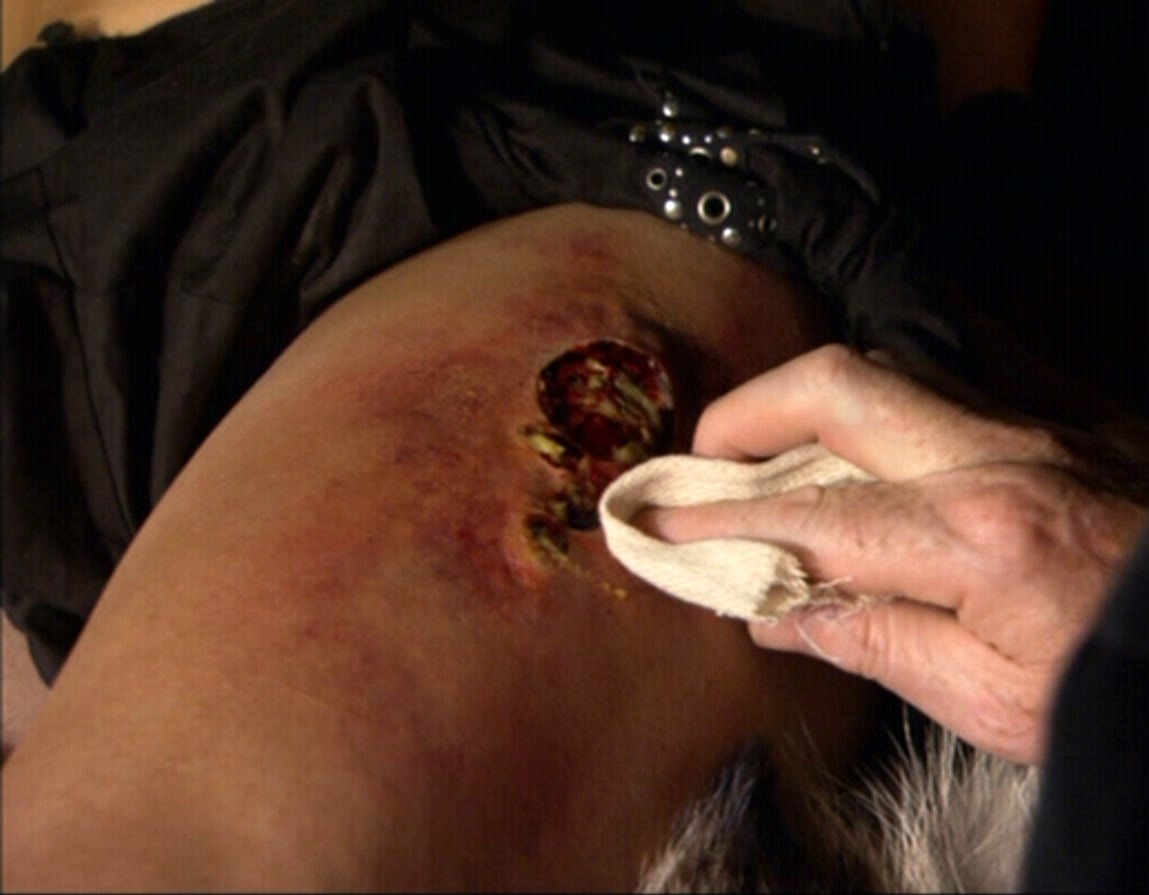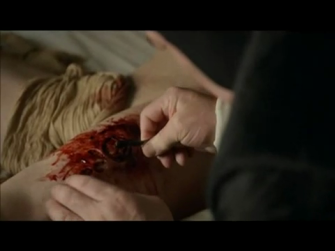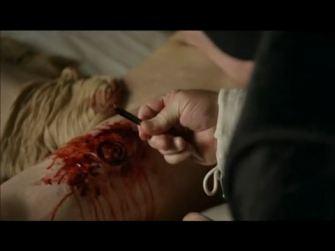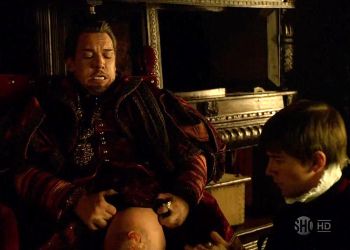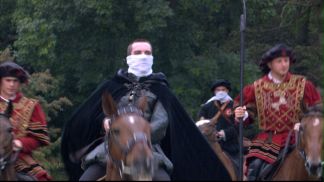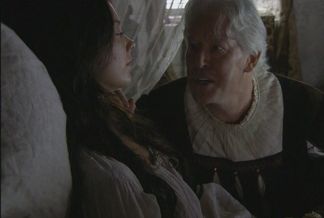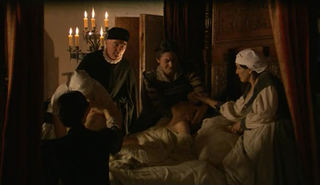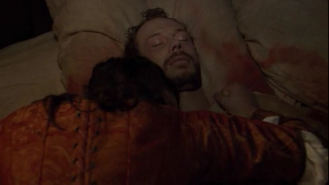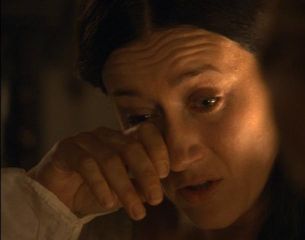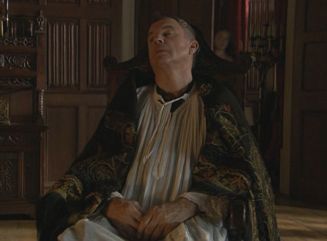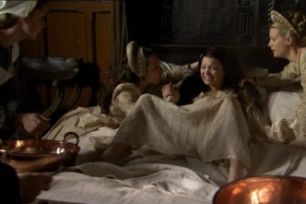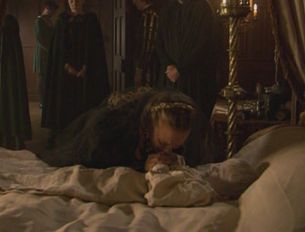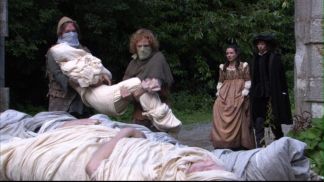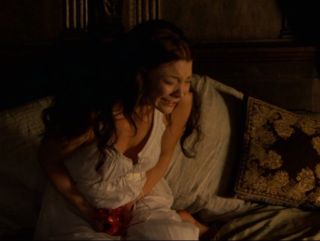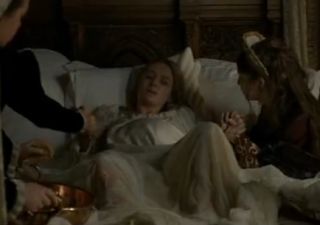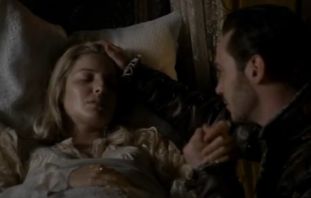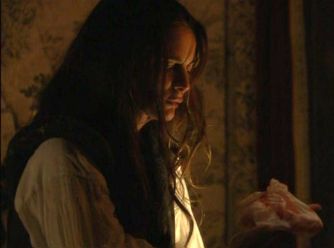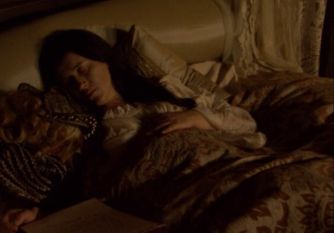MEDICINE & the Tudors
Jump to navigation
Jump to search
Save
| Sweating sicknesses, Childbirth, Miscarriages & Jousting Accidents were important events in The Tudors series Click EasyEdit to update this page! (Don't see the EasyEdit button above? <a href="/#signin" target="_self">Sign in</a> or <a href="/accountnew" target="_self">Sign up</a>.) |
| The King's Medical Personnel consisted of : |
| Apothecaries (Richard Babham, Cuthbert Blackenden, Thomas Alsop,Thomas Ashe, John De Soda & Thomas Pierson) - These were kept busy preparing physiks for Henry to relieve his constipation and gout. |
| Barber-Surgeons (Thomas Vicary) - Specialization of professions is a relatively new invention. Back then, barbers were also dentists and surgeons, versatile performers of tooth extraction and enemas, bloodletting and wound surgery. Vickary was called a sergeant-surgeon to the court in recognition of his skill with battle wounds. The most common way to stay healthy in Tudor times was to employ a barber-surgeon to bleed all your family members every spring equinox. |
 Physicians (Dr. Thomas Linacre, Dr. Water Cromar, Dr. William Butts, Dr. George Owens and Dr. John Chambre who attended the births of both Princess Elizabeth Tudor & Prince Edward Tudor ) Usually men of the priesthood who held ecclesiastical offices as well. The Royal College of Physicians was founded by King Henry VIII in September 1518 with Dr. Linacre as President. Physicians (Dr. Thomas Linacre, Dr. Water Cromar, Dr. William Butts, Dr. George Owens and Dr. John Chambre who attended the births of both Princess Elizabeth Tudor & Prince Edward Tudor ) Usually men of the priesthood who held ecclesiastical offices as well. The Royal College of Physicians was founded by King Henry VIII in September 1518 with Dr. Linacre as President.Along with the regular physicians there were also others who attended the king. Dr. Andrew Boorde recorded that the King was "fleshy" with pronounced arteries possessed of ruddy cheeks and pale skin "hair plenty and red, pulse great and full, digestion perfect, anger short [and] sweat abundant". In Henry's final years, he was attended by George Owens, Thomas Wendy (William Butts successor) and Robert Huicke. Physicians were trained in all the intellectual refinements. They studied astronomy, astrology, geometry, mathematics, music and philosophy. They provided a holistic approach, treating a patient's mental, moral and physical needs. They believed that a sickness or canker's root cause might be in the mind, the organs or the human spirit. Fate, fortune and goodwill might cure when a physik failed. The Tudors believed strongly in a divine plan in the face of providence . That life was "God given" and could also be "God taken". From birth, Henry's astrological lore was minutely examined.Born under the sign of cancer (28 June 1491), he was governed by the watery and maternal cycles of the moon. [source: Dr. Elizabeth T. Hurren - senior lecturer History of medicine at Oxford Brookes University] |
<embed allowfullscreen="true" height="340" src="http://wikifoundrytools.com/wiki/thetudorswiki/widget/youtubevideo/715bf829737c7c5757f861a1519caae94e7941e2" type="application/x-shockwave-flash" width="560" wmode="transparent"/> A delve deep into the medical world of the Tudors. Opening up Henry VIIIs medical case notes to examine his famed ill-health and hypochondria, and discovers that the soothsayers should have paid greater attention to his star sign. Dr Hurren and other historians talking talk about medicine, the body and the natural world. [Source: <a class="external" href="http://www.youtube.com/user/HistoricRoyalPalaces" rel="nofollow" target="_blank">HistoricRoyalPalaces</a>May 22, 2009] |
LINKS:
|
| King Henry's Medical Record: |
| During his youth, he enjoyed reasonably good health but the Doctors were kept busy examining royal urine, stools & sputum. To keep him in humoural balance he was regularly bled & cupped according to the phases of the moon. 1521 - Fevers & sinusitis 1528 - Chronic Headaches, bladder trouble & a possible tumor of the testicles. 1532 - Painful attacks in the extremities 1536 - Jousting accident - Henry is unconscious for 2 hours. 1537 - Minor Pulmonary Embolism 1541 - Flare up of old leg wound. After the leg wound ulcerated Henry experienced recurrent colds & a "choleric" disposition. Modern doctors believe he may have suffered from Osteomyelitis, a chronic septic infection of the thigh bone due to the jousting accident in 1536 which caused necrosed pieces of bone & pus. It has also been proposed that he suffered from scurvy as he exhibited every symptom which progressively debilitated him and produced violent changes of temper. Standard treatments for Syphilis were not used and that theory was only proposed in 1888 and has since been discounted. Diabetes has also been considered as a strong possibility for Henry's ailments. [Source : The Royal Doctors, 1485-1714 By Elizabeth Lane Furdell] *See also King Henry VIII Controversies Sir Arthur McNalty in his book, "Henry VIII, a Difficult Patient," also provides that Henry's ulcer was caused by osteomyelitis, dating back to the jousting injury. The disease would produce the hideous pus-ridden sores, but would explain the intermittent nature of the ulcers. |
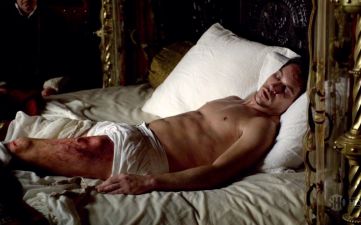 | 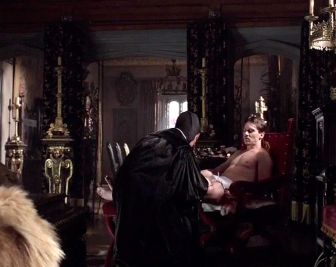 |
Season 4
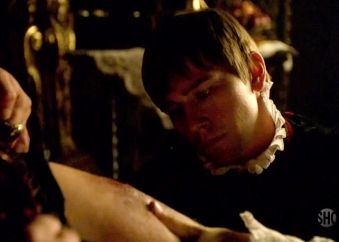 | |
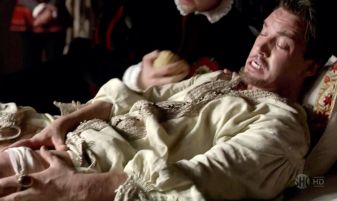 | 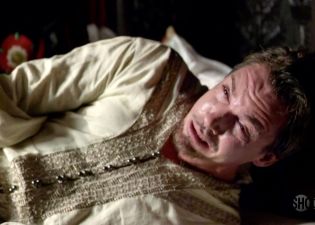 |
<embed allowfullscreen="true" height="350" src="http://wikifoundrytools.com/wiki/thetudorswiki/widget/youtubevideo/50c3ecde29cf78dbb5403bf494e2718213d3e86e" type="application/x-shockwave-flash" width="425" wmode="transparent"/> Source : <a class="external" href="http://www.youtube.com/user/HistoricRoyalPalaces" rel="nofollow" target="_blank">HistoricRoyalPalaces</a> on May 22, 2009 Experts discuss the likely causes of the death of Henry VIII on 28 Jan 1547. |
| Medical Theory |
| During this period, medicine adhered to Galenic precepts & the humoural explanation for illness. There were 4 "humours" or bodily fluids which governed the body : - Blood - Phlegm - Yellow Bile - Black Bile Personality was also affected by the "Humours". People with too much blood were sanguine, or ardent & hopeful. Those with too much phlegm were phlegmatic, or dull & apathetic; melancholiacs, the depressed & unhappy suffered from immoderate black bile and the peevish & cross are understandably bilious were burdened with superfluous yellow bile. There should be a balance of humours - warm, cold, dry, moist - because a surfeit or deficit of the humours caused sickness. An overabundance of blood caused fever but bleeding the patient could restore wellness. Purging with laxatives, vomitories & other prescriptions eliminated redundant humours or relieved humoural shortages. Physicians also advised on diets since food was considered medicinal if prepared properly. |
| The Sweating Sickness was a form of influenza with pulmonary complications. Some felt that the "sweats" were God's scourge on those without the right piety and others argued that the disease emanated from "foul" or corrupt air. Some believe this to be a form of Tudor Cholera. It is estimated that between 1525 and 1527 nearly 50 people died per day. | Childbirth & Miscarriages Midwives & "wise women" handled obstetric care since Tudor Physicians considered most cases be left to the safe conduct of the Invisible Midwife " Dame Nature" |
| Symptoms started with a "summer fever" . Then the patient developed severe cramp, headache and dizziness. A rash then broke out covering the body with black spots. In about 4 hours, they were said to be as "stiff as a wall". Henry was deathly afraid of being contaminated and made it a rule to never visit a sick person. The French Ambassador to the English court, Du Bellai, wrote in 1528, "...One of the filles de chambre of Mlle Boleyn was attacked on Tuesday by the sweating sickness. The King left in great haste, and went a dozen miles off...This disease is the easiest in the world to die of. You have a slight pain in the head and at the heart; all at once you begin to sweat. There is no need for a physician: for if you uncover yourself the least in the world, or cover yourself a little too much, you are taken off without languishing. It is true that if you merely put your hand out of bed during the first 24 hours...you become stiff as a poker". The French Ambassador said that Henry was "the most timid person in such matters you could meet with". When Anne Boleyn came down with the illness in their early courtship he despatched his physician with a letter for a speedy recovery but remained at a distance. | Margaret Beaufort, Henry's grandmother bequeathed a terrible standard to her grandson. At just 13 years old she gave birth to Henry's father. The birth was excruciatingly painful and prolonged. Her womb prolapsed but she had fulfilled her duty. Her only male child secured the Tudor line of succession. To young Henry his grandmother personified the supreme female sacrifice. Where she had succeeded, he could not fail. His cold calculating drive to serve dynastic ends made Henry an obsessive husband. Though reported to be a considerate and affectionate lover, he also bullied his wives in the bedchamber. This context would result in a litany of failed childbirth attempts that beleagured his marriages. It is a curious fact that by the time Henry's early wives carried to term, they fell into a modern conception-category - "elderly primagravida"(pregnant 35+). Relentless attempts to conceive meant that Katherine of Aragon and later Anne Boleyn were older mothers and thus would experience a much higher risk of miscarriages and stillbirths. |
| Anne Boleyn survives a bout with the Sweating Sickness much to her father, Sir Thomas Boleyn's glee. Season 1 | Elizabeth (Bessie) Blount gives birth to Henry Fitzroy Henry's illegitimate son. Season 1 |
| Sadly Sir William Compton succumbs to the sweating sickness and does not survive. Season 1 | *Number of Children stillborn or born weak disputed See : <a class="external" href="http://www.pubmedcentral.nih.gov/picrender.fcgi?artid=1139382&blobtype=pdf" rel="nofollow" target="_blank" title="The alleged miscarriages of Catherine of Aragon and Anne Boleyn. by J Dewhurst">The alleged miscarriages of Catherine of Aragon and Anne Boleyn. by J Dewhurst</a> |
| Cardinal Thomas Wolsey survives the Sweating Sickness epidemic. Season 1 | Anne Boleyn gives birth to Princess Elizabeth Tudor Season 2 |
| Henry Fitzroy dies from the Sweating Sickness at a very young age * Season 1 | Anne Boleyn would suffer several* miscarriages. Season 2 *Number of miscarriages disputed Author Mike Ashley speculated that Anne had two stillborn children after Elizabeth's birth and before the birth of the male child she miscarried in 1536. [Ashley, p.240.] Most sources attest only to the birth of Elizabeth in September 1533, a possible miscarriage in the summer of 1534, and the miscarriage of a male child, of almost four months gestation, in January 1536. [Williams, chapter 4.] 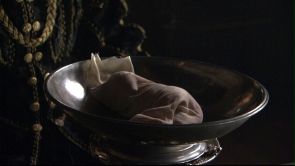 The series buys into the deformed foetus theory proposed by Retha Warnicke however most historians (Ives, Starkey, Fraser) dismiss it as catholic propaganda See also : Anne Boleyn Controversies |
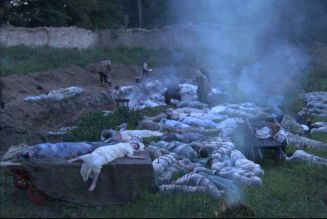 | Jane Seymour gives birth to Prince Edward Tudor |
| Jane Seymour died from a post-natal infection about 12 days after giving birth to Prince Edward. Season 3 | |
| Other Ailments |
| Princess Margaret Tudor dies from consumption*. Season 1 *Historically, Mary died from consumption/poor health, Margaret died from a stroke. | Queen Katherine of Aragon is believed to have died from Cancer due to a black tumor like growth on her heart. Season 2 |
LINKS:
| Sources: |
Save
